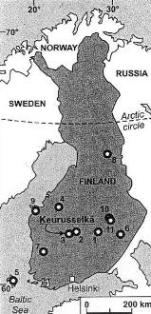Too many holes

In the History of Meteoritics
1 I concluded it was unlikely that the 170 or so terrestrial structures attributed to impact would be found to have other causes. However, in a recent review
2, I wrote that the crowd of such structures recognised in Scandinavia remained unexplained (there are 62 in all, of which a likely 26 are confirmed by shock effects
3). A recent article by Ferrière et al.
4 gives a map of those confirmed by shock effects in Finland alone, and all 11 fall within an area extending for ~500km in the country’s southern half. They are of widely different ages and do not represent a single bombardment.
Only a handful of Quaternary craters of up to 1-2km diameter have a meteoritic material association: Wolfe Creek and Barringer being the most renowned, while there is also the single 25km diameter Pliocene Eltanin structure in the deep southern ocean (with mesosiderite and howardite specks). Shock effects in quartz and shatter cones, believed not to occur in endogenous terrestrial explosive structures, have been entirely relied on to confirm the remainder.
The shocked quartz in the Keurusselkä structure, newly described and finely illustrated
3, do, in their droplet-decorated shock lamellae, resemble the remarkable shock-melting droplets which I illustrated long ago when describing the Mount Padbury mesosiderite’s eucrite inclusions
5. However, this extreme crowding of large-scale structures in Finland, makes me re-iterate my remarks
1,2 concerning the very marked geographic imbalance in the distribution of such structures, which is not to be satisfactorily explained in terms of large impact frequency. There remains a niggling doubt in my mind whether the opposing views of Bucher6, Nicolaysen7 and Currie8, that shock effects alternatively derive from some form of cryptoexplosion structures, generated from within our planet, may not yet come back into play.
References
- McCall, G.J.H. 2006. Meteorite cratering; Hooke, Gilbert, Barringer and beyond. In: McCall, G.J.H., Bowden, A.J., Howarth, R.J., eds., The History of Meteoritics and key meteorite Collections. Geological Society of London Special Publication 256; 443-469
- McCall, G.J.H. 2009. Half a century of progress in research on terrestrial impact structures. Earth Science Reviews 92; 99-116.
- McCall, G.J.H. 2008. Paasselkä crater. Geoscientist 18 (3); 10
- Ferrière, L., Raiskila, S, Osinki, G.R., Pesonen, L.J., Lehtinen, M. 2010. The Keurusselkä impact structure,Finland. Impact origin confirmed by characterization of planar deformation features in quartz grains. Meteoritics & Planetary Science 45; 434-446.
- McCall, G.J.H., Cleverly, W.H. 1968. The petrology of the Mt. Padbury mesosiderite and it achondrite enclaves. Mineralogical Magazine 35; 1029-160.
- Bucher, W.H. 1963. Cryptoexplosion structures caused from within or without the Earth (‘Astroblemes’ or Geoblemes’ ?). American Journal of Science 262; 596-649.
- Nicolaysen, L.O. 1972. North American cryptoexplosion structures interpreted as diapirs, which obtain relief from strong natural confinement. Geological Society of America Memoir 132; 605-620.
- Currie, K.L. 1972. Geology and petrology of the Manicouagan resurgent caldera. Geological Survey of Canada Bulletin vol. 198; 153 pp.